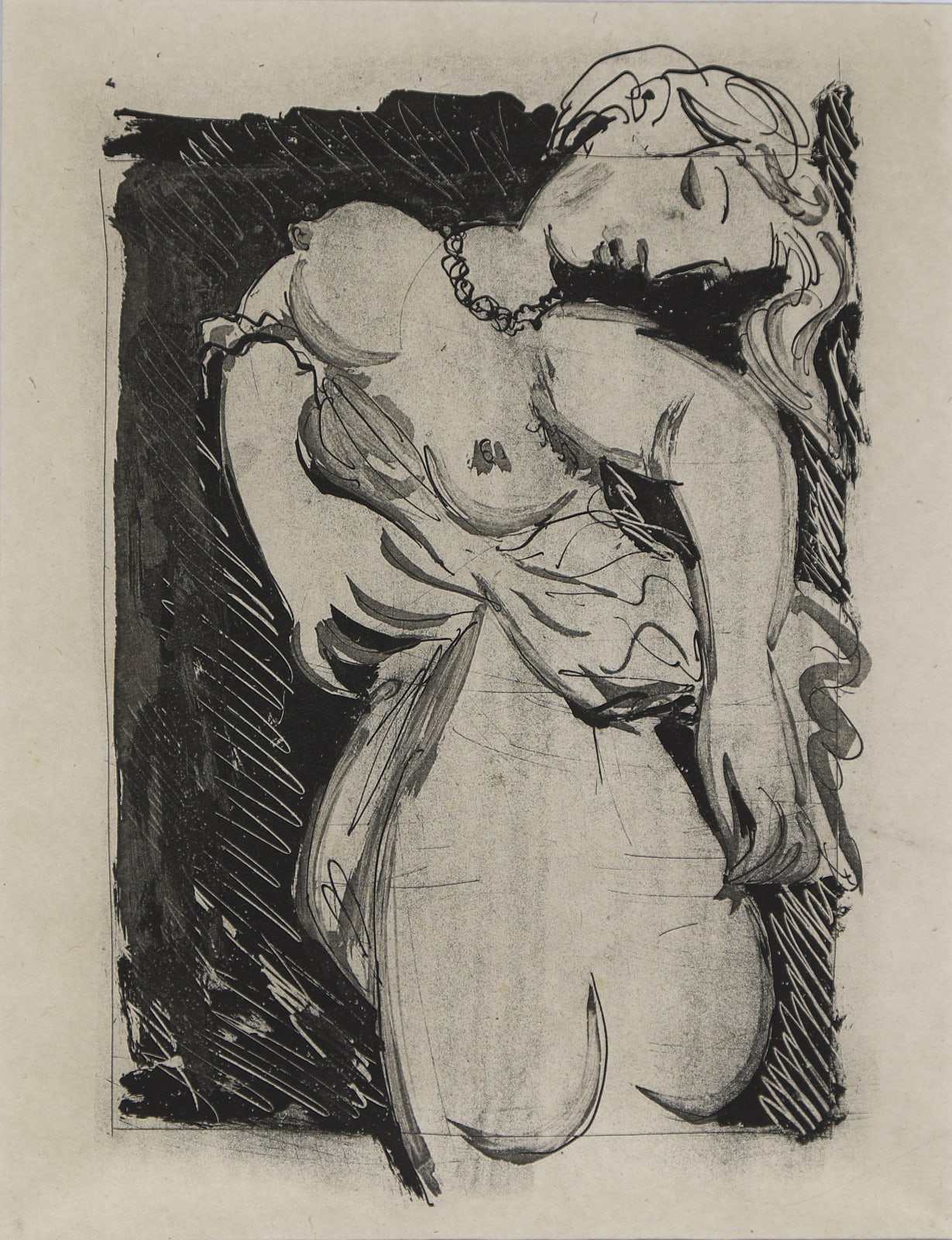Modern
Pablo Picasso Spanish, 1881-1973
Martin Fabiani, éditeur. imprimée par Lacourière
L'un des très rares essais d'artiste sur Chine, en plus de l'édition numérotée, qui ne porte pas le titre de La Puce.
Les contours de la femme et ses cheveux sont éclaircis au grattoir. La planche est reprise au sucre : pinceau et bâtonnet de bois. La chemise, les cheveux, les contours de la femme sont précisés ; elle porte un collier. Le haut de sa tête dépasse nettement l'encadrement. Le fond est entièrement couvert d'aquatinte travaillée de tailles claires. L'aquatinte dépasse nettement l'encadrement inférieur et teinte légèrement toute la composition.
Marthe Fequet et Pierre Baudier, imprimeurs et typographes d’Art, ont imprimé les œuvres ma- jeures des grands Maîtres français et étrangers du XXe siècle. Dès le XIXe siècle, les bibliophiles ont pris l'habitude de se réunir au sein de sociétés d'amateurs. Cette mode a connu son apogée au XXè siècle, dans l'entre-deux guerres. À cette époque, Féquet et Baudier vont imprimer un nombre considérable de “ Beaux Livres “ pour les éditeurs les plus prestigieux : Ambroise Vollard et Martin Fabiani, ainsi que pour de nombreuses sociétés de bibliophiles. Après guerre, avec les éditeurs Ai- mé Maeght, Louis Broder, Gérard Cramer ou encore Pierre Lecuire qui vont, eux aussi, leur confier l’impression de leurs plus beaux livres, Féquet et Baudier vont contribuer pleinement au rayonne- ment de “ l’Âge d’Or ” de l’estampe et du livre illustré en France, qui fit naître une grande compli- cité entre artistes et artisans. Ayant mis leur génie inventif au service des artistes, nombreux furent ceux comme Miro, Matisse, Arp, Braque, Chagall ou encore Nicolas de Staël qui leur confièrent l’impression de leurs estampes. Pendant plus d’un demi-siècle, l’imprimerie Féquet et Baudier a été, sans doute, l’imprimerie la plus prisée. Quelques-uns des plus beaux livres de peintres modernes sont nés dans leurs ateliers.
Histoire Naturelle de Buffon, illustré par Picasso
Pablo Picasso, comme Joan Miró, Henri Matisse, Marc Chagall, Georges Rouault ou André Masson, a beaucoup collaboré aux livres illustrés. Ainsi a-t-il réalisé à la demande d'Ambroise Vollard - cinq ans après leur aventure commune autour du Chef d'œuvre inconnu de Balzac - une série de gravures pour l'Histoire Naturelle de Buffon (1749-1789).
Picasso commença à travailler à cet ouvrage en février 1936, impatient d'expérimenter la nouvelle technique de la gravure à l'aquatinte, que Roger Lacourière venait de lui faire découvrir. Cette gravure à l'eau-forte se réalise sur une plaque de cuivre saupoudrée de grains d'une résine colophane ou bitume très résistante à l'acide. La préparation est ensuite chauffée puis plongée dans l'acide ce qui permet d'obtenir une surface composée de points et non de traits offrant une gamme de tons de gris très subtile.
Picasso réalisa 32 gravures entre 1936 et 1937, imprimées en 1937, mais qui suite au décès accidentel de Vollard en juillet 1939 ne furent jamais publiées. Il fallut attendre mai 1942 pour que l'associé et successeur de Vollard, Marin Fabiani, reprenne la publication de l'œuvre de Buffon.
Le portfolio de l'Histoire Naturelle a été publié dans une édition de 226 exemplaires : trente-six sur divers papiers contenant une suite supplémentaire avec remarques, cinquante-cinq sur vélin Montval et cent trente-cinq sur vélin Vidalon. L'artiste exécuta ses planches avec une grande spontanéité. En atteste les marges à main levée, la ligne tracée rapidement, ainsi que la marque des doigts.
Picasso inscrivit le nom de chacun des animaux sur ses eaux-fortes (sauf dans le cas du loup). Toutefois, ce faisant, il prit certaines libertés. Ainsi le bœuf de Buffon est devenu "Le Taureau", qui à son tour a été changé pour "Le Toro espagnol". L'artiste préféra également "La Biche" au cerf, et "La Lionne" au lion. Ces noms, écrits en grosses lettres, ont été intentionnellement omis pour la publication du livre, et ne figurent que sur les impressions de la suite qui accompagne l'édition de luxe. Picasso fit une 32ème gravure, intitulée "La Puce". Cette dernière ne fut jamais incluse dans le livre. On y voit une pucelle arrachant une puce... Et si la personne représentée est l'Aphrodite callipyge, les traits du visage sont ceux de Marie-Thérèse Walter.
Provenance
Ancienne collection Fequet & Baudier
Literature
Georges Bloch, Pablo Picasso, Catalogue de l'œuvre gravé et lithographié, Vol. I, 1904 - 1967, Berne, Editions Kornfeld & Klipstein, 1968, n° 359
Brigitte Baer, Picasso peintre-graveur, Éditions Kornfeld n° 606
Sebastian Goeppert, Herma Goeppert-Frank Patrick Cramer, Pablo Picasso, Catalogue raisonné
Join our mailing list
* denotes required fields
We will process the personal data you have supplied in accordance with our privacy policy (available on request). You can unsubscribe or change your preferences at any time by clicking the link in our emails.
